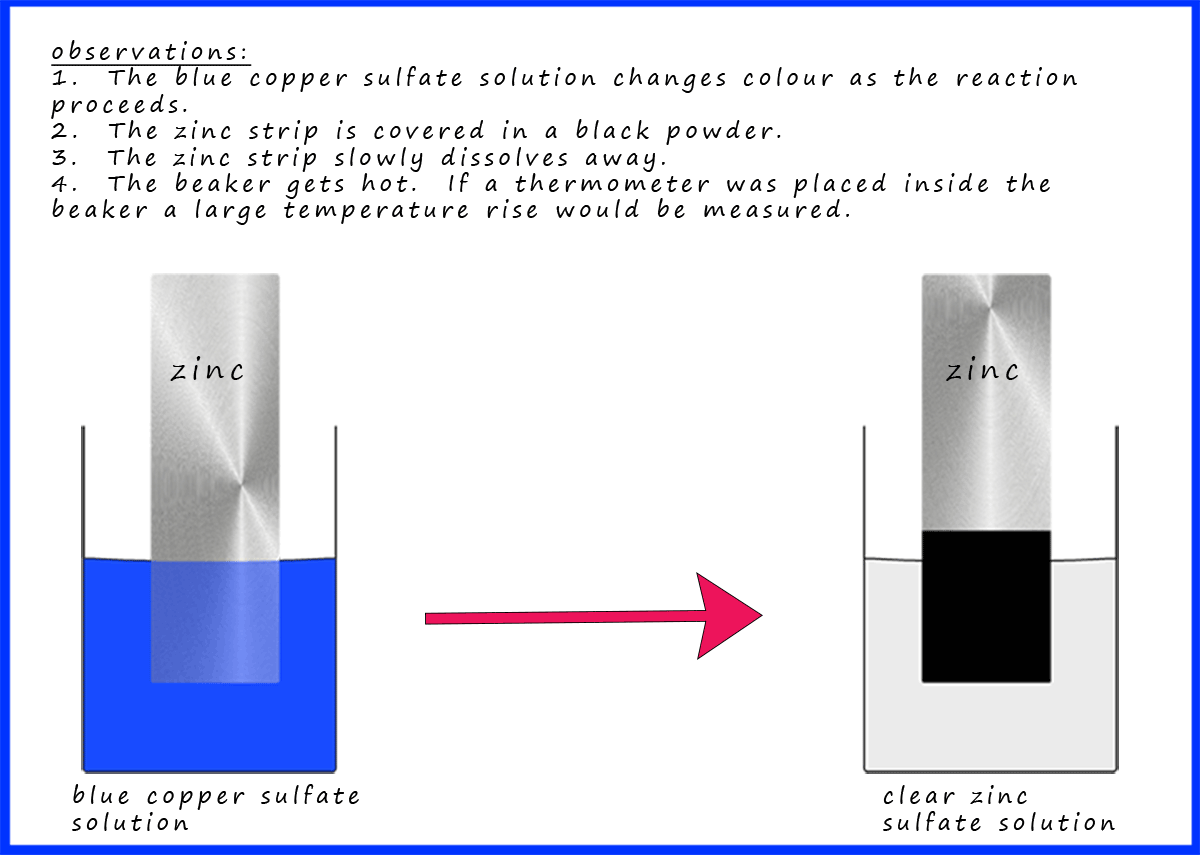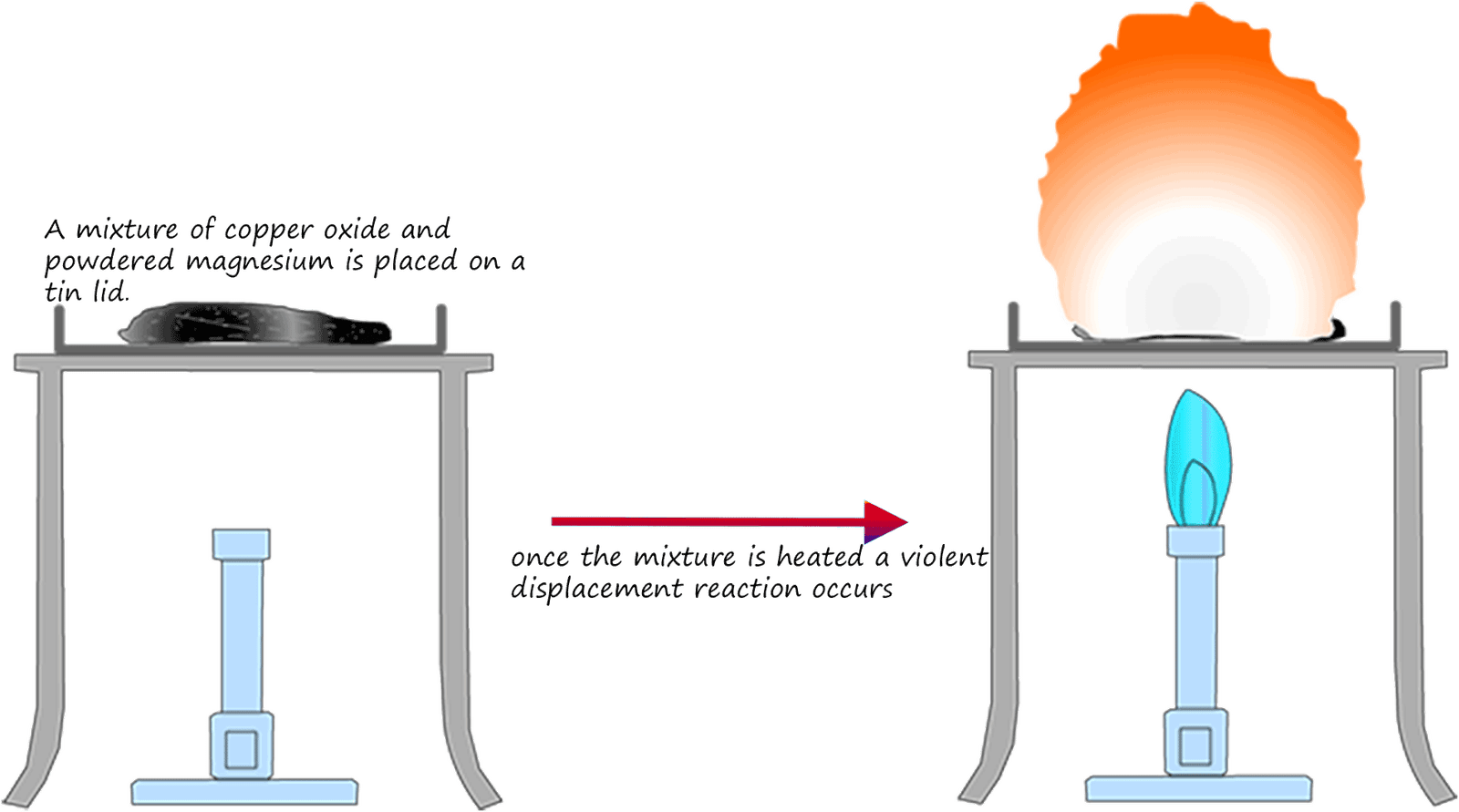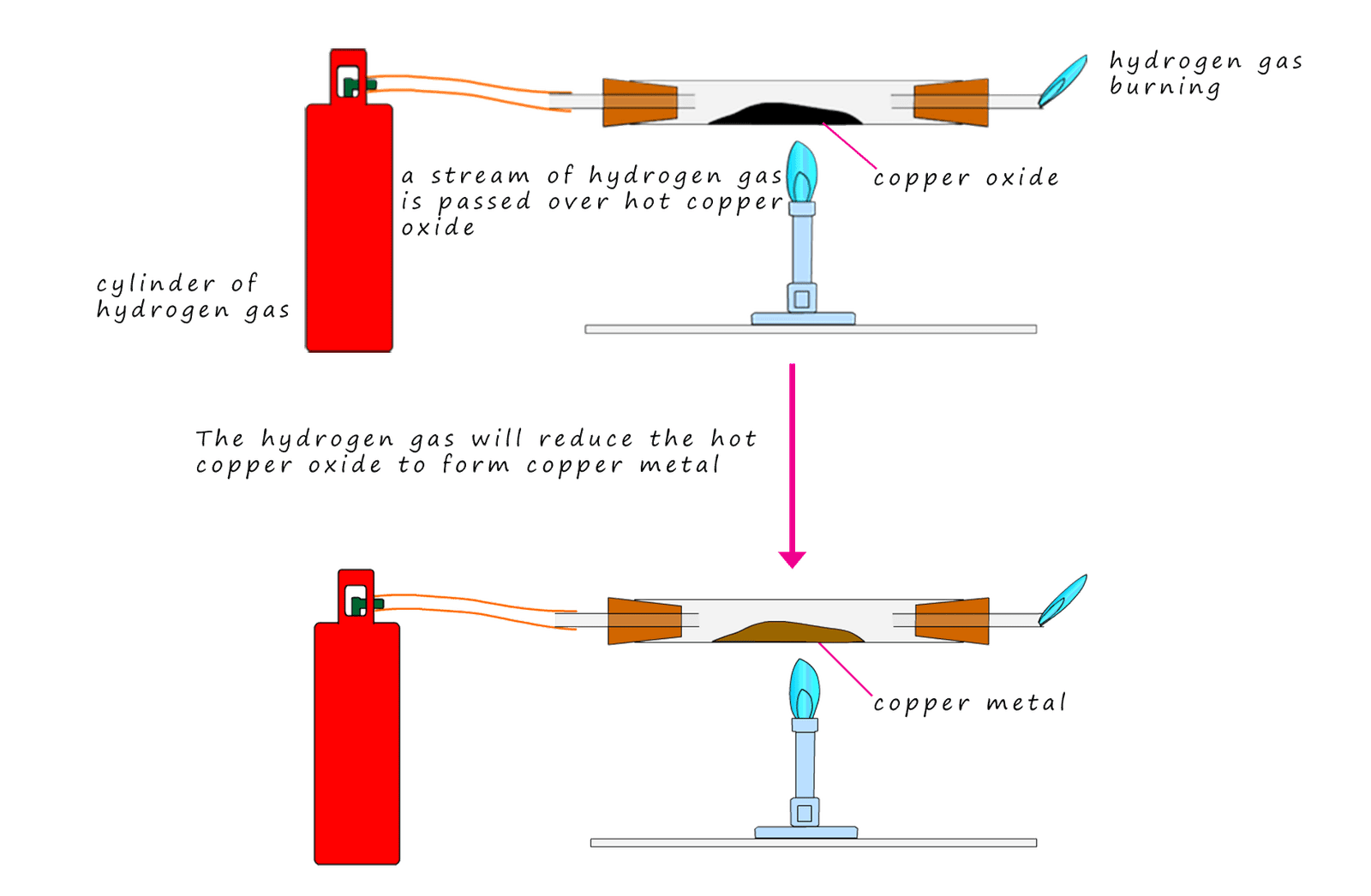Higher and foundation tiers
Displacement reactions
Displacement reactions are a good way to demonstrate the order of reactivity of metals. In a
displacement reaction a more
reactive metal will remove or displace a less reactive metal from its compound or solution.
The reactivity series for metals is shown lower down this page; it will help you work out what is happening in the equations below. You may notice that two non-metals, carbon and hydrogen have
been included in the reactivity series. This is simply because these are two common reagents that are frequently reacted with metal compounds; often to extract metals from their ores.
Consider the following displacement reaction where a strip of zinc metal is dipped into a copper sulfate solution for about
60 seconds. When the strip of zinc is removed it will be covered in a thin layer of black copper powder (note
copper metal is
usually a bronze colour but damp copper powder appears black!).

| potassium |
| sodium |
| lithium |
| calcium |
| magnesium |
| aluminium |
| carbon |
| zinc |
| iron |
| tin |
| lead |
| hydrogen |
| copper |
| silver |
| gold |
| platinum |
In this reaction there are 2 metals present; copper and zinc.
From the reactivity series shown opposite you can see that
zinc is the more reactive metal of the two. In a
displacement reaction the more
reactive metal displaces the less
reactive metal from its compound or solution, we can show this using a general formula to show what happens in a displacement reaction using the equation below:
Metal A + Metal B salt or solution → Metal A salt or solution + Metal B
So in this example the zinc metal will displace
or remove the copper ions from the copper sulfate solution.
Word and symbolic equations for this displacement reaction are shown below:
zinc(s) + copper sulfate(aq) → zinc sulfate(aq) + copper(s)
Zn(s) + CuSO4(aq) → ZnSO4(aq) + Cu(s)
An ionic equation is simply the symbolic equation with the charges on the ions shown, these ionic equations are helpful in identifying
what has been reduced and what has been oxidised during a chemical reaction. The ionic equation for this reaction is:
Zn(s) + Cu2+SO42-(aq) → Zn2+SO42-(aq) + Cu(s)
Here you can see that the zinc atoms lose two electrons and form zinc ions (Zn2+) while the copper ions (Cu2+) gain two electrons and are reduced to form copper atoms. In this reaction the sulfate ion (SO42- )is a
spectator ion;
this means it remains unchanged in the reaction; it takes no part in the reaction. If we re-write the ionic equation
but omit the spectator ions we have:
Zn(s) + Cu2+(aq) → Zn2+(aq) + Cu(s)
We can simplify this further by using half equations for each of the reactants:
Zn(s) → Zn2+(aq) + 2e this is an oxidation reaction
The zinc metal reacts to form zinc sulfate, an ionic compound containing zinc ions (Zn2+). The copper ions in the copper
sulfate solution gain 2
electrons from the zinc and are reduced to copper atoms.
Cu2+(aq) + 2e → Cu(s) this is a reduction reaction
This is an oxidation/reduction reaction or a redox reaction. By combining the two half equations and cancelling
out the electrons
we get the overall equation for the reaction.
Zn(s) → Zn2+(aq) + 2e this is an oxidation reaction
Cu2+(aq) + 2e → Cu(s) this is a reduction reaction
Zn(s) + Cu2+(aq) → Zn2+(aq) + Cu(s) overall equation for reaction
More displacement reactions
Displacement reactions involving solutions are fun and safe to carry out in the lab. However reactions involving
solids are much more violent and much more care is needed to ensure they are carried out safely. The diagram below
illustrates the reaction between magnesium powder and copper oxide. Here the more reactive
magnesium metal displaces or
removes the less reactive copper from the solid copper oxide. This reaction is very violent!

Equations for this reaction are:
magnesium(s) + copper oxide(s) → magnesium oxide(s) + copper(s)
Mg(s) + CuO(s) → MgO(s) + Cu(s)
The further apart the two metals are in the reactivity series the more violent and explosive the reactions become.
If the copper oxide in the above reaction is replaced with silver nitrate then an explosive reaction occurs,
this reaction is extremely violent and a large amount of heat and light is released in the resulting explosion.
The reaction is more violent since the two metals involved; silver and magnesium are further apart in the reactivity
series. Once the two reactants are mixed a simple drop of water will cause this explosive reaction to start, there is no need to heat the mixture. The reaction can be summarised as:
magnesium(s) + silver nitrate(s) → magnesium nitrate(s) + silver(s)
Mg(s) + 2AgNO3(s) → Mg(NO3)2(s) + 2Ag(s)
In both these examples the more reactive metal is oxidised, it loses electrons
and the less reactive metal is reduced, it gains electrons.
These reactions are displacement reactions but they are also redox reactions.
Using hydrogen gas to displace unreactive metals
Hydrogen, though not a metal reacts in many cases as if it was a metal.
In terms of reactivity hydrogen sits just above copper in the
reactivity series. This means that it can be used to displace
any metal below it in the reactivity series such as
copper or
silver. The image below shows how copper oxide can be reduced to copper metal
using a stream of hydrogen gas from a cylinder.

Equations to show this displacement reaction are shown below:
copperx oide(s) + hydrogen(g) → copper(s) + hydrogen oxide(g)
CuO(s) + H2(g) → Cu(s) + H2O(g)
Key Points
- A displacement reaction is one where a more reactive metal will remove a less reactive metal from its compounds or
a solution.
- The more reactive metal is oxidised and the less reactive metal is reduced in a
displacement reaction
Practice questions
Next




